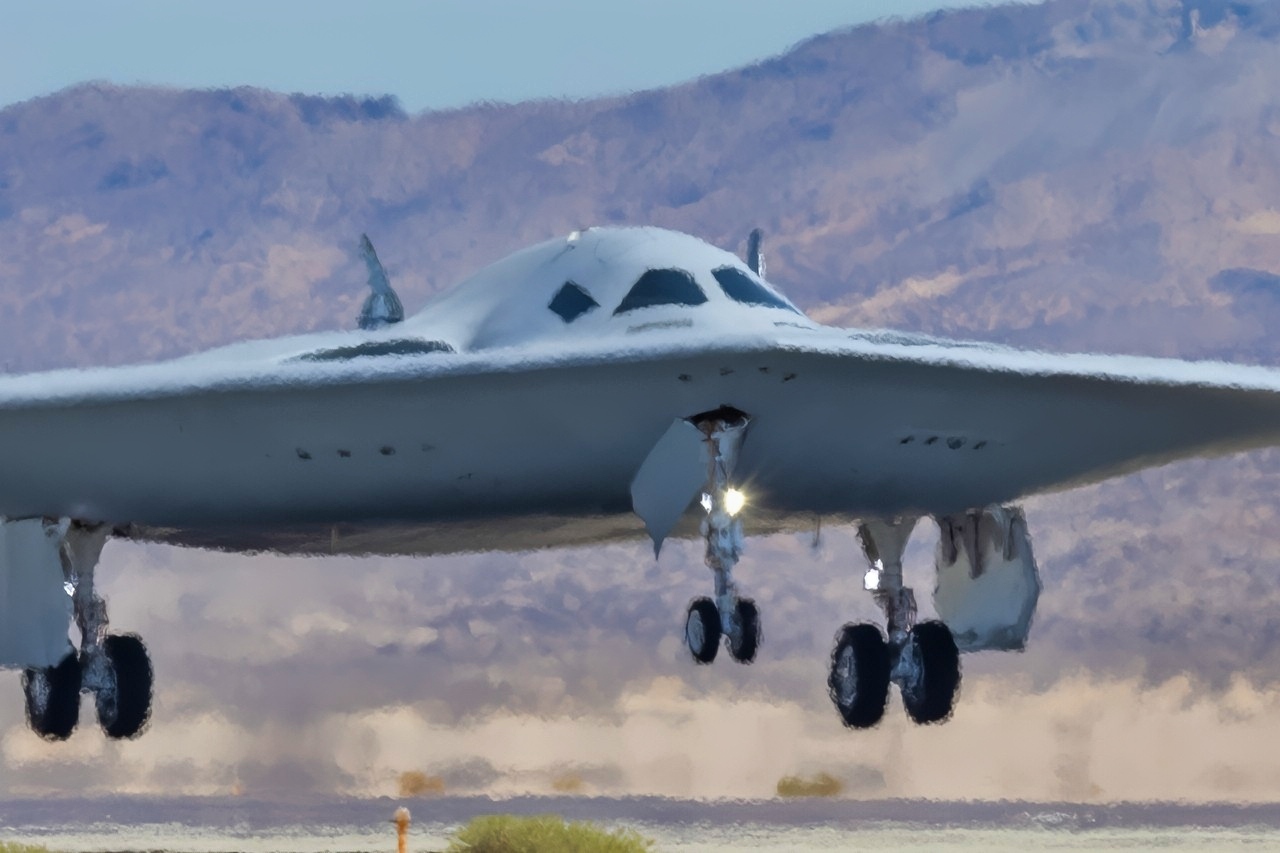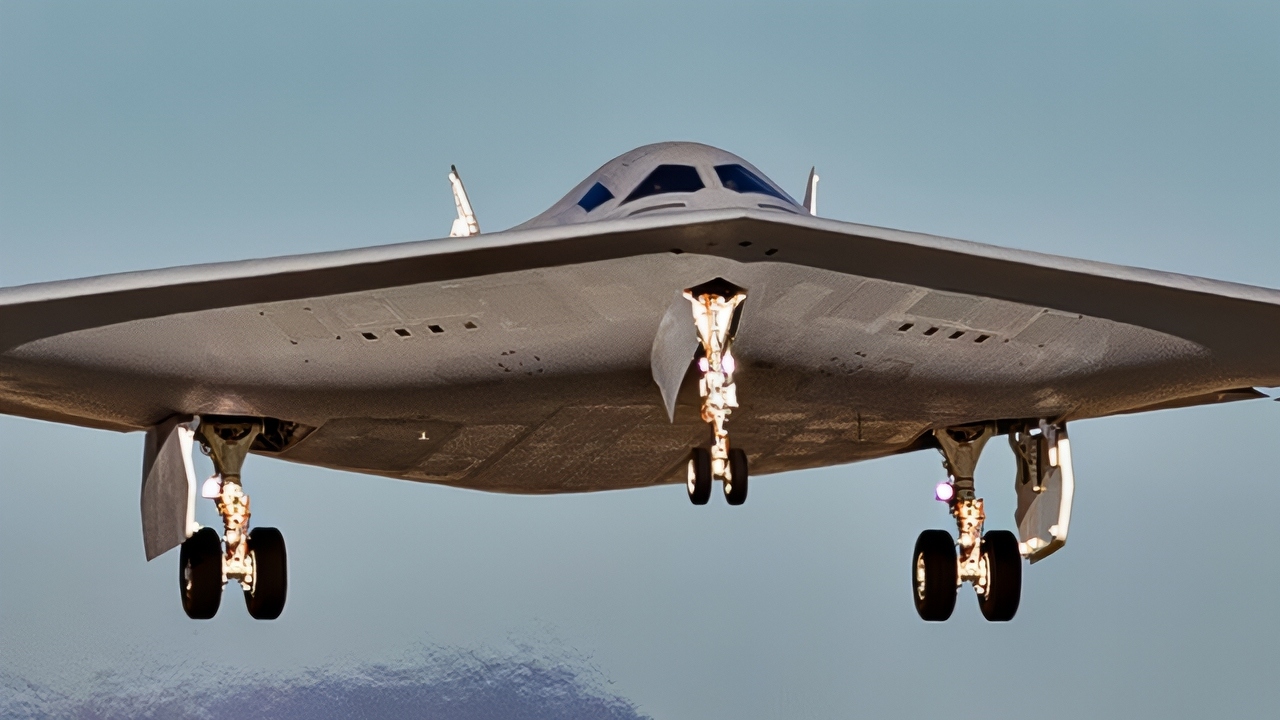Will 100 B-21 Raiders Be Enough For War With China or Russia?
The new Northrop Grumman B-21 Raider, the next-generation stealth bomber, is set to replace the aging B-2 Spirit and B-1 Lancers as the backbone of the US Air Force’s strategic bomber fleet.

U.S. Air Force Airmen with the 912th Aircraft Maintenance Squadron prepare to recover the second B-21 Raider to arrive for test and evaluation at Edwards AFB, Calif., Sept. 11, 2025. The arrival of a second test aircraft provides maintainers valuable hands-on experience with tools, data and processes that will support future operational squadrons. (U.S Air Force photo by Kyle Brasier)

A B-21 Raider test aircraft lands at Edwards Air Force Base, Calif., during ongoing developmental flight testing, Sept. 11, 2025. The B-21 will be the backbone of the bomber fleet; it will incrementally replace the B-1 Lancer and B-2 Spirit bombers. (U.S Air Force photo by Todd Schannuth)
It is expected that although China and Russia pursue advanced bomber designs of their own, the B-21 Raider’s technology will keep it a step ahead of its opponents for the next generation of air warfare.
However, the issue facing the Air Force isn’t with the bomber itself, but with the number of B-21s that the US plans to purchase.
Currently, the official US policy is to buy just 100 Raiders.
Is this sufficient to win a protracted war with China or Russia in the near future?
Can this math problem get solved or not?
Not Enough B-21 Raider Bombers, Regardless of How Good It Is
No, most analysts and military strategists argue that a fleet of 100 B-21 Raiders would be insufficient to deter and win a protracted war against China or Russia simultaneously, with many calling for a much larger fleet of 200 to 400 B-21s to maintain strategic deterrence and meet global combat demands.
The B-21 Raider stealth bomber will be one of the stealthiest airplanes in U.S. history.

A second B-21 Raider, the nation’s sixth-generation stealth bomber, joins flight testing at Edwards Air Force Base, Calif., Sept. 11, 2025. The program is a cornerstone of the Department of the Air Force’s nuclear modernization strategy, designed to deliver both conventional and nuclear payloads. (Courtesy photo)

A second B-21 Raider, the world’s sixth-generation stealth bomber, test aircraft arrives at Edwards Air Force Base, Calif., Sept. 11, 2025. The addition of the second test aircraft expands mission systems and weapons integration testing, advancing the program toward operational readiness. (Courtesy photo)

U.S. Air Force Airmen with the 912th Aircraft Maintenance Squadron prepare to recover the second B-21 Raider to arrive for test and evaluation at Edwards AFB, Calif., Sept. 11, 2025. The arrival of a second test aircraft provides maintainers valuable hands-on experience with tools, data and processes that will support future operational squadrons. (U.S Air Force photo by Kyle Brasier)
The Air Force has ordered 100 B-21 Raiders, but the number needs to be increased.
A fleet of B-21s would serve the United States well, as potential conflicts with great powers such as China and Russia loom on the horizon. However, the United States may need between 200 and 250 of the B-21s.
The Center for Strategic and Budgetary Assessments recommends 288 B-21s, suggesting a significantly larger fleet is necessary.
A larger fleet would ensure a credible deterrent, allow for suppression of advanced air defenses, support continuous operations, and hedge against potential attrition.
No Cold War This Time?
The Chinese Communist Government told its soldiers to be ready for war by 2027, and that comment may not be mere saber-rattling.
They’ve made their intentions clear on Taiwan and their designs on the South China Sea, where they claim nearly all of it.
The unfortunate truth is that if war breaks out between the US and China, it wouldn’t be shocking if the Russians joined in, too. Russia and China have long tried to weaken the US on the world stage.
Russia is in no shape to engage the US in a conventional conflict. Their failures in Ukraine have been costly in terms of personnel, arms, and equipment, and these failures are well-documented.
However, Russia will attempt to take advantage of a war between China and the US to reacquire some of the Baltic states that were once part of the Soviet Union. Those aims are already taking shape today with their bellicose incursions into NATO airspace.
China has been undergoing a major rebuilding effort for its armed forces for decades, and it may feel that a stretched-thin US will be unable to stop its Navy from dominating the seas in the Indo-Pacific.
Which is why 100 B-21 stealth bombers won’t be enough if this scenario unfolds.
Why 100 B-21s May Not Be Enough
The argument for a 100-bomber force centers around what transpired with the B-2 Spirit. The collapse of the Soviet Union and the end of the Cold War, showcased that (at that time) the US didn’t need a massive bomber fleet.
That scenario is unlikely to occur in this or the next generation, particularly with the Chinese, Russian, and other potential adversaries.
The 100 B-21 Raider fleet should be the absolute floor in terms of procurement, not the maximum. The original 100 bombers were selected before the US realized that it would need to deter China and Russia simultaneously, and the PRC’s number of strategic systems has rapidly grown since then.
The B-21, Smaller, More Flexible, Survivable
The B-21’s compact design will allow it to penetrate China’s area denial strategy, known as Anti-Access/Area Denial (A2/AD) defenses more effectively, ensuring it can deliver precision strikes or gather intelligence in high-threat environments where the larger B-2 might face greater risks.
The B-21’s smaller size also translates into greater operational flexibility. The B-2 Spirit, with its massive wingspan and heavy payload capacity, was designed for long-range, high-payload missions, often carrying large nuclear or conventional munitions over intercontinental distances.
One potential force multiplier factor is that the B-21 could play a key role in multi-domain operations, integrating with space, cyber, and ground-based assets to provide a comprehensive and coordinated response to threats, including the CCA “loyal wingman” program.
The B-21’s open-system architecture will allow frequent updates to its onboard systems, not only affecting the types of weapons it can carry, but also making it easier to increase the bomber’s avionics.
It has been reported that the B-21 is capable of taking off and landing on smaller, more austere airfields. The aircraft will not require the climate-controlled hangars that the B-2s do.
What Is The Cost Of Peace? More B-21 Raider Bombers
The B-21 Raider is not just a weapon of war; it is a weapon of peace.
The deterrence of having a next-generation stealth bomber is invaluable. And having enough of the B-21s that can fly and penetrate any enemy’s A2/AD defenses will give those enemies pause should they decide to go to war with the US.
There is, and will continue to be, discussion about the cost of building so many of these stealth bombers. Ultimately, the cost of not building them will be much higher for the country in the long run.
About the Author: Steve Balestrieri
Steve Balestrieri is a National Security Columnist. He served as a US Army Special Forces NCO and Warrant Officer. In addition to writing on defense, he covers the NFL for PatsFans.com and is a member of the Pro Football Writers of America (PFWA). His work was regularly featured in many military publications.
More Military
Su-57 Felon vs. Eurofighter Typhoon: Who Wins?
The P-8A Poseidon Might Be the Ultimate Submarine Hunter
The S-3 Viking: The Best Submarine Killer Retired?










